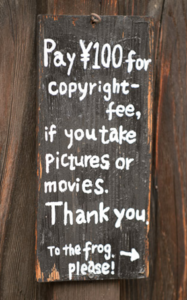
While strolling through Ninenzaka in Kyoto, I stumbled upon a wall adorned with intricate “Noh” masks. Traditionally used in classical Japanese performance art, these masks often represent supernatural beings transformed into human heroes who recount stories drawn from ancient literature. On stage, emotions are conveyed through stylized and deliberate gestures—but here, it seemed the artist had captured the spirit of Noh theater in the masks themselves, capturing the same expressive and hyper-stylized energy.
What particularly caught my attention was a small sign next to the artwork: “Pay 100 yen for copyright fee if you take pictures or movies,” accompanied by a slot in one of the masks for depositing coins. It was a clever approach to protecting and monetizing creative expression.

Working in intellectual property law, I appreciated the artist’s initiative. Intellectual property can be monetized in a variety of ways—through licensing agreements, joint ventures, or outright transfers of rights. This was a simple yet effective reminder of the value of creative work and the many forms that IP monetization can take. I was glad to contribute the 100 yen and support their art, while also taking a moment to continue supporting IP systems.

